steering wheel FORD C MAX 2008 1.G Owner's Manual
[x] Cancel search | Manufacturer: FORD, Model Year: 2008, Model line: C MAX, Model: FORD C MAX 2008 1.GPages: 278, PDF Size: 17.5 MB
Page 122 of 278
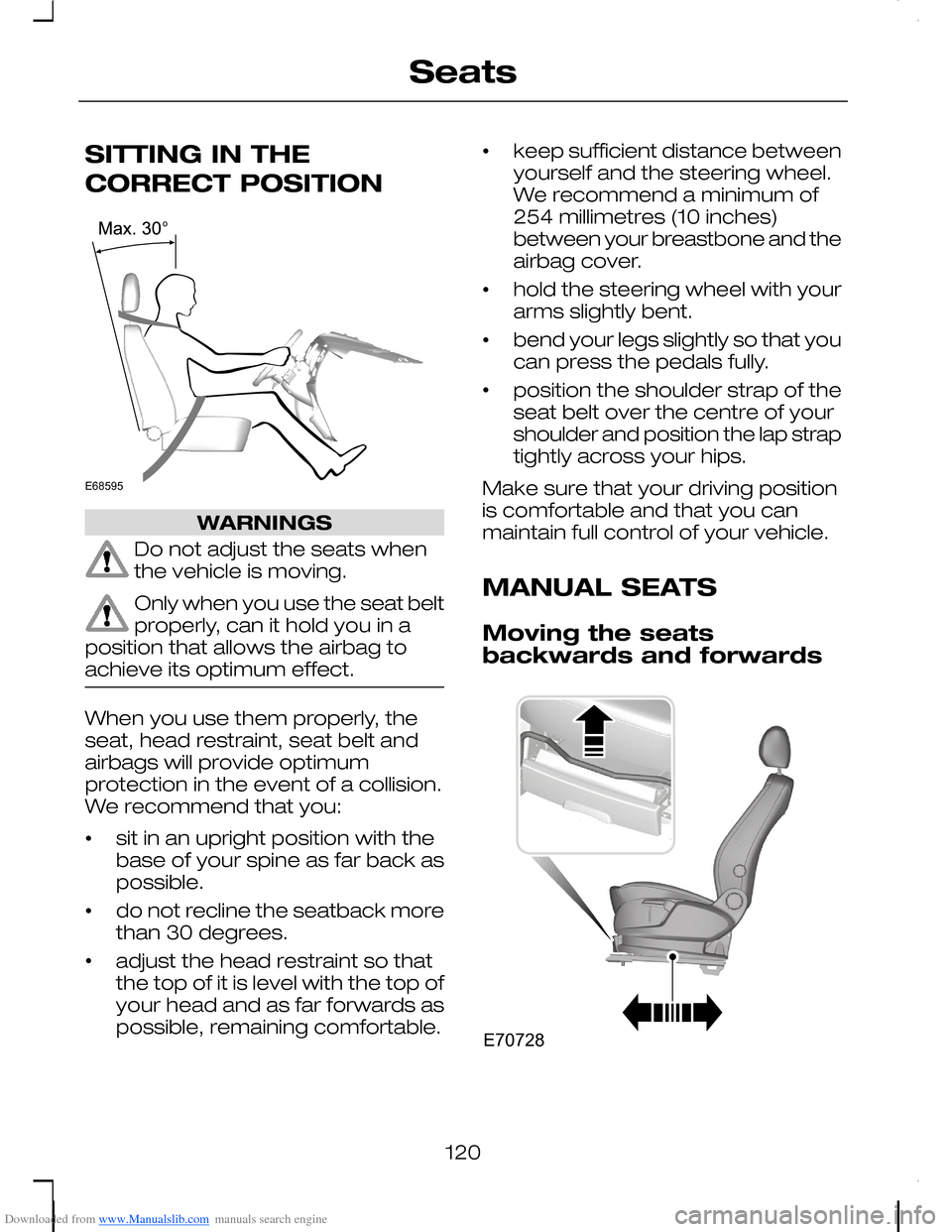
Downloaded from www.Manualslib.com manuals search engine SITTING IN THE
CORRECT POSITION
WARNINGS
Do not adjust the seats whenthe vehicle is moving.
Only when you use the seat beltproperly, can it hold you in aposition that allows the airbag toachieve its optimum effect.
When you use them properly, theseat, head restraint, seat belt andairbags will provide optimumprotection in the event of a collision.We recommend that you:
•sit in an upright position with thebase of your spine as far back aspossible.
•do not recline the seatback morethan 30 degrees.
•adjust the head restraint so thatthe top of it is level with the top ofyour head and as far forwards aspossible, remaining comfortable.
•keep sufficient distance betweenyourself and the steering wheel.We recommend a minimum of254 millimetres (10 inches)between your breastbone and theairbag cover.
•hold the steering wheel with yourarms slightly bent.
•bend your legs slightly so that youcan press the pedals fully.
•position the shoulder strap of theseat belt over the centre of yourshoulder and position the lap straptightly across your hips.
Make sure that your driving positionis comfortable and that you canmaintain full control of your vehicle.
MANUAL SEATS
Moving the seatsbackwards and forwards
120
SeatsE68595 E70728
Page 144 of 278
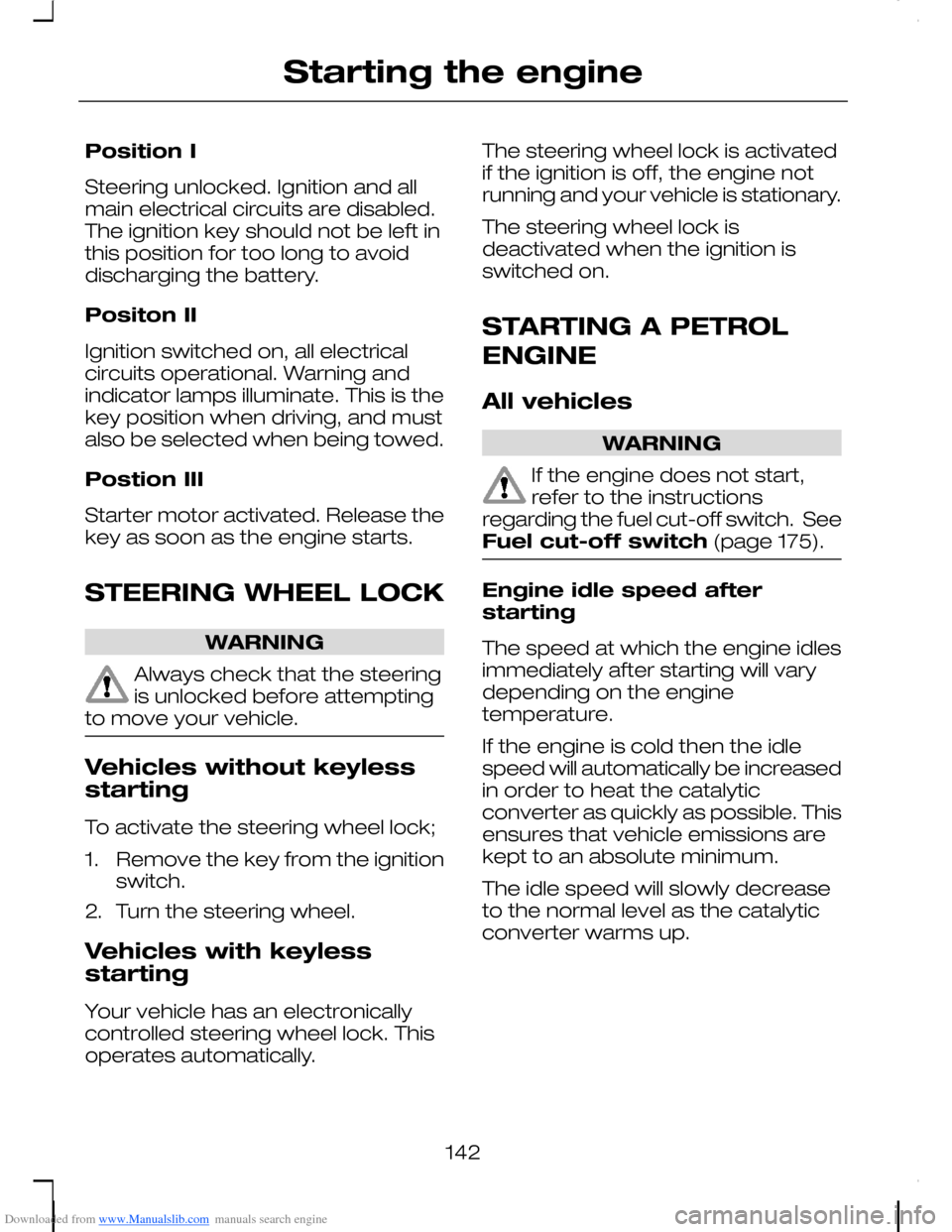
Downloaded from www.Manualslib.com manuals search engine Position I
Steering unlocked. Ignition and allmain electrical circuits are disabled.The ignition key should not be left inthis position for too long to avoiddischarging the battery.
Positon II
Ignition switched on, all electricalcircuits operational. Warning andindicator lamps illuminate. This is thekey position when driving, and mustalso be selected when being towed.
Postion III
Starter motor activated. Release thekey as soon as the engine starts.
STEERING WHEEL LOCK
WARNING
Always check that the steeringis unlocked before attemptingto move your vehicle.
Vehicles without keylessstarting
To activate the steering wheel lock;
1.Remove the key from the ignitionswitch.
2.Turn the steering wheel.
Vehicles with keylessstarting
Your vehicle has an electronicallycontrolled steering wheel lock. Thisoperates automatically.
The steering wheel lock is activatedif the ignition is off, the engine notrunning and your vehicle is stationary.
The steering wheel lock isdeactivated when the ignition isswitched on.
STARTING A PETROL
ENGINE
All vehicles
WARNING
If the engine does not start,refer to the instructionsregarding the fuel cut-off switch. SeeFuel cut-off switch (page 175).
Engine idle speed afterstarting
The speed at which the engine idlesimmediately after starting will varydepending on the enginetemperature.
If the engine is cold then the idlespeed will automatically be increasedin order to heat the catalyticconverter as quickly as possible. Thisensures that vehicle emissions arekept to an absolute minimum.
The idle speed will slowly decreaseto the normal level as the catalyticconverter warms up.
142
Starting the engine
Page 148 of 278
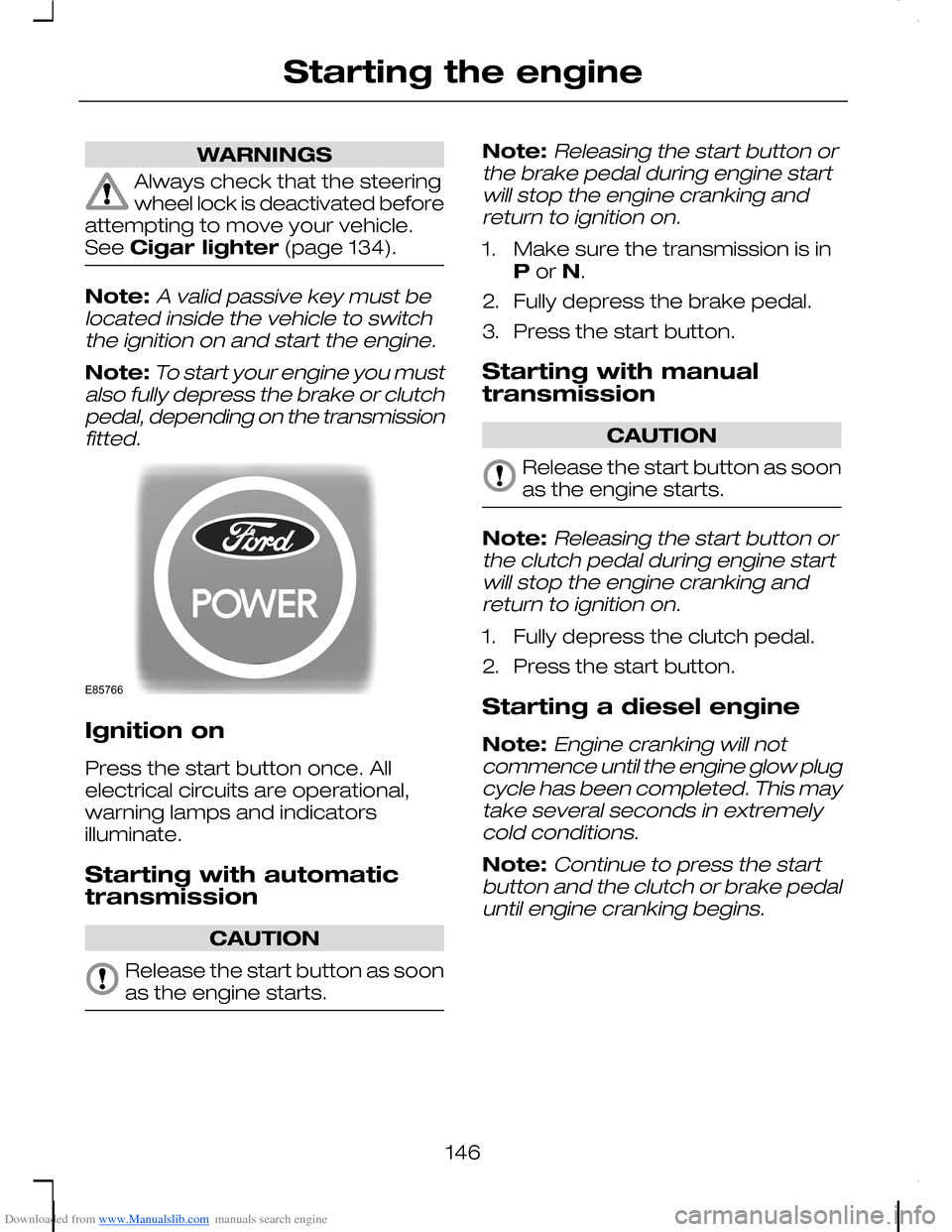
Downloaded from www.Manualslib.com manuals search engine WARNINGS
Always check that the steeringwheel lock is deactivated beforeattempting to move your vehicle.See Cigar lighter (page 134).
Note:A valid passive key must belocated inside the vehicle to switchthe ignition on and start the engine.
Note:To start your engine you mustalso fully depress the brake or clutchpedal, depending on the transmissionfitted.
Ignition on
Press the start button once. Allelectrical circuits are operational,warning lamps and indicatorsilluminate.
Starting with automatictransmission
CAUTION
Release the start button as soonas the engine starts.
Note:Releasing the start button orthe brake pedal during engine startwill stop the engine cranking andreturn to ignition on.
1.Make sure the transmission is inP or N.
2.Fully depress the brake pedal.
3.Press the start button.
Starting with manualtransmission
CAUTION
Release the start button as soonas the engine starts.
Note:Releasing the start button orthe clutch pedal during engine startwill stop the engine cranking andreturn to ignition on.
1.Fully depress the clutch pedal.
2.Press the start button.
Starting a diesel engine
Note:Engine cranking will notcommence until the engine glow plugcycle has been completed. This maytake several seconds in extremelycold conditions.
Note:Continue to press the startbutton and the clutch or brake pedaluntil engine cranking begins.
146
Starting the engineE85766
Page 160 of 278
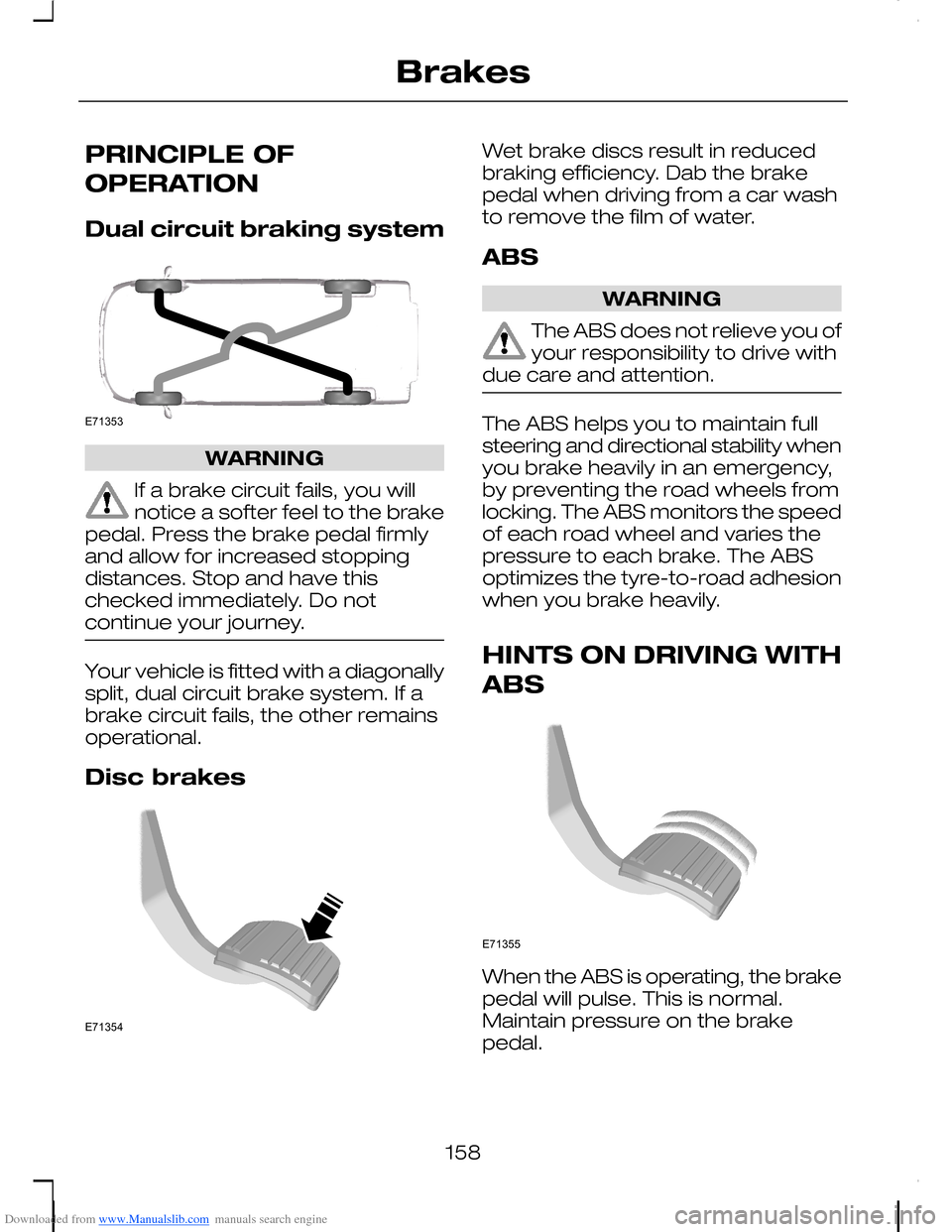
Downloaded from www.Manualslib.com manuals search engine PRINCIPLE OF
OPERATION
Dual circuit braking system
WARNING
If a brake circuit fails, you willnotice a softer feel to the brakepedal. Press the brake pedal firmlyand allow for increased stoppingdistances. Stop and have thischecked immediately. Do notcontinue your journey.
Your vehicle is fitted with a diagonallysplit, dual circuit brake system. If abrake circuit fails, the other remainsoperational.
Disc brakes
Wet brake discs result in reducedbraking efficiency. Dab the brakepedal when driving from a car washto remove the film of water.
ABS
WARNING
The ABS does not relieve you ofyour responsibility to drive withdue care and attention.
The ABS helps you to maintain fullsteering and directional stability whenyou brake heavily in an emergency,by preventing the road wheels fromlocking. The ABS monitors the speedof each road wheel and varies thepressure to each brake. The ABSoptimizes the tyre-to-road adhesionwhen you brake heavily.
HINTS ON DRIVING WITH
ABS
When the ABS is operating, the brakepedal will pulse. This is normal.Maintain pressure on the brakepedal.
158
BrakesE71353 E71354 E71355
Page 161 of 278

Downloaded from www.Manualslib.com manuals search engine The ABS will not eliminate thedangers inherent when:
•you drive too close to the vehiclein front of you.
•the vehicle is aquaplaning.
•you take corners too fast.
•the road surface is poor.
PARKING BRAKE
All vehicles
WARNING
Vehicles with an automatictransmission should always beleft with the selector lever in positionP.
•Press the foot brake pedal firmly.
•Pull the parking brake lever upsmartly to its fullest extent.
•Do not press the release buttonwhile pulling the lever up.
•If your vehicle is parked on a hilland facing uphill, select first gearand turn the steering wheel awayfrom the kerb.
•If your vehicle is parked on a hilland facing downhill, select reversegear and turn the steering wheeltowards the kerb.
To release the parking brake, pressthe brake pedal firmly, pull the leverup slightly, depress the releasebutton and push the lever down.
159
BrakesE70430
Page 166 of 278
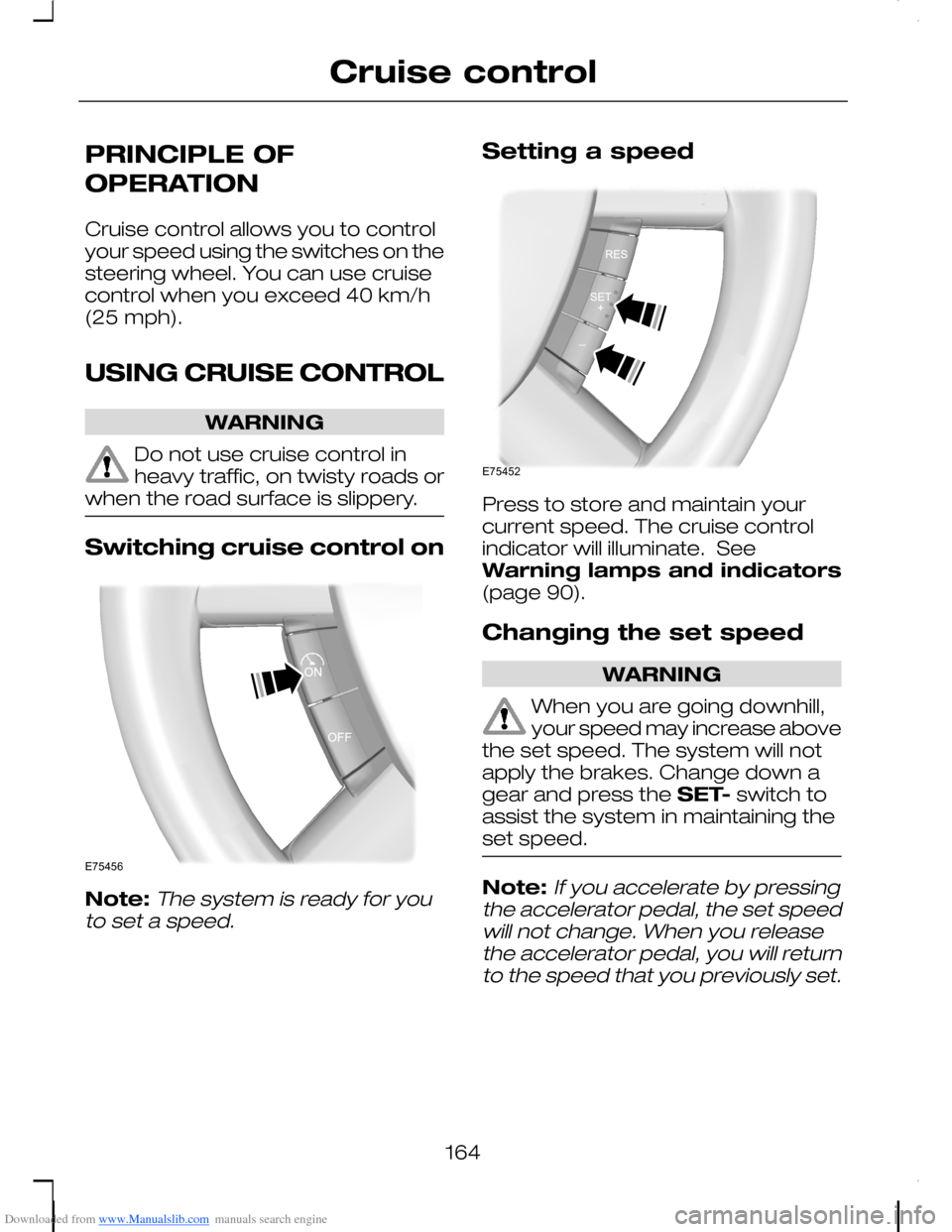
Downloaded from www.Manualslib.com manuals search engine PRINCIPLE OF
OPERATION
Cruise control allows you to controlyour speed using the switches on thesteering wheel. You can use cruisecontrol when you exceed 40 km/h(25 mph).
USING CRUISE CONTROL
WARNING
Do not use cruise control inheavy traffic, on twisty roads orwhen the road surface is slippery.
Switching cruise control on
Note:The system is ready for youto set a speed.
Setting a speed
Press to store and maintain yourcurrent speed. The cruise controlindicator will illuminate. SeeWarning lamps and indicators(page 90).
Changing the set speed
WARNING
When you are going downhill,your speed may increase abovethe set speed. The system will notapply the brakes. Change down agear and press the SET- switch toassist the system in maintaining theset speed.
Note:If you accelerate by pressingthe accelerator pedal, the set speedwill not change. When you releasethe accelerator pedal, you will returnto the speed that you previously set.
164
Cruise controlE75456 E75452
Page 188 of 278
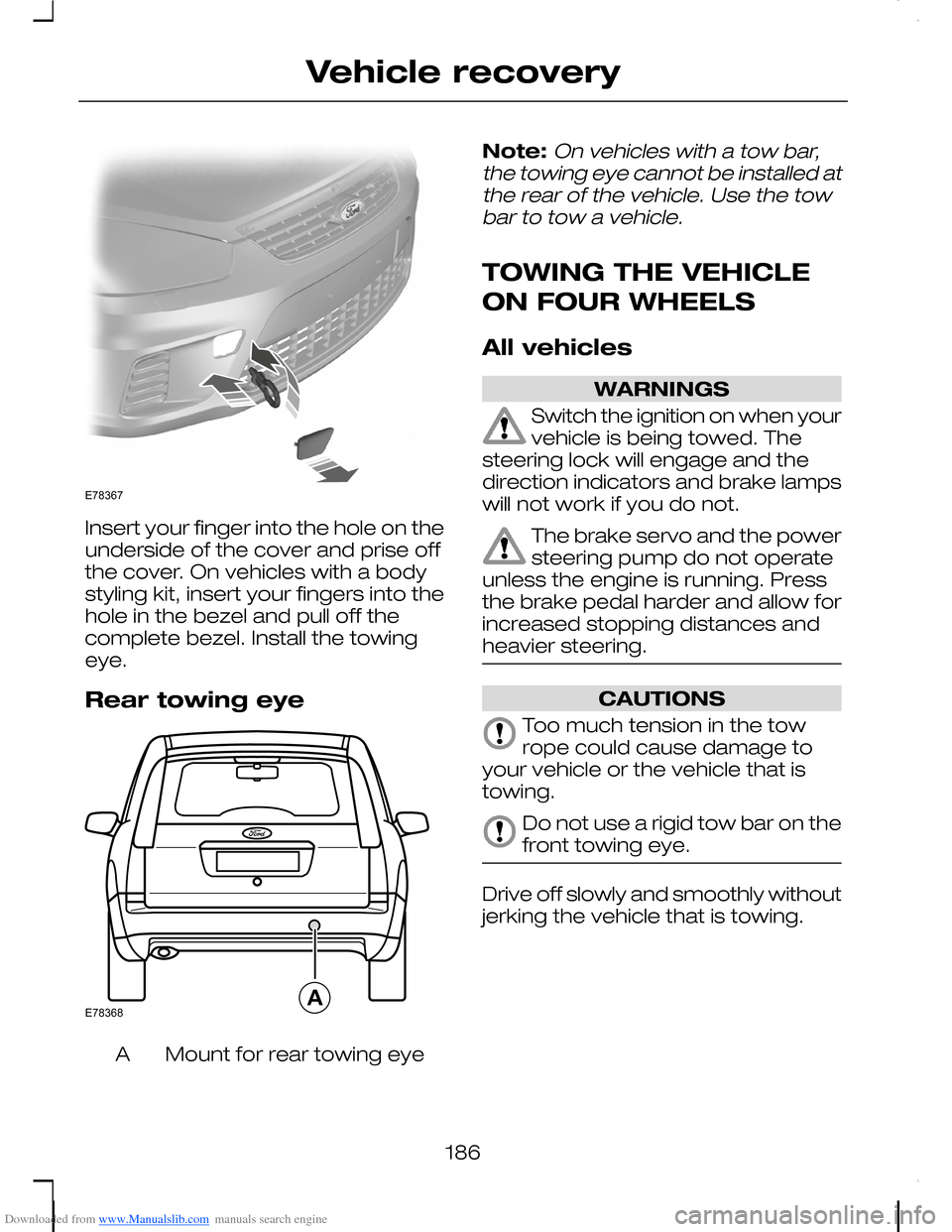
Downloaded from www.Manualslib.com manuals search engine Insert your finger into the hole on theunderside of the cover and prise offthe cover. On vehicles with a bodystyling kit, insert your fingers into thehole in the bezel and pull off thecomplete bezel. Install the towingeye.
Rear towing eye
Mount for rear towing eyeA
Note:On vehicles with a tow bar,the towing eye cannot be installed atthe rear of the vehicle. Use the towbar to tow a vehicle.
TOWING THE VEHICLE
ON FOUR WHEELS
All vehicles
WARNINGS
Switch the ignition on when yourvehicle is being towed. Thesteering lock will engage and thedirection indicators and brake lampswill not work if you do not.
The brake servo and the powersteering pump do not operateunless the engine is running. Pressthe brake pedal harder and allow forincreased stopping distances andheavier steering.
CAUTIONS
Too much tension in the towrope could cause damage toyour vehicle or the vehicle that istowing.
Do not use a rigid tow bar on thefront towing eye.
Drive off slowly and smoothly withoutjerking the vehicle that is towing.
186
Vehicle recoveryE78367 E78368
Page 190 of 278
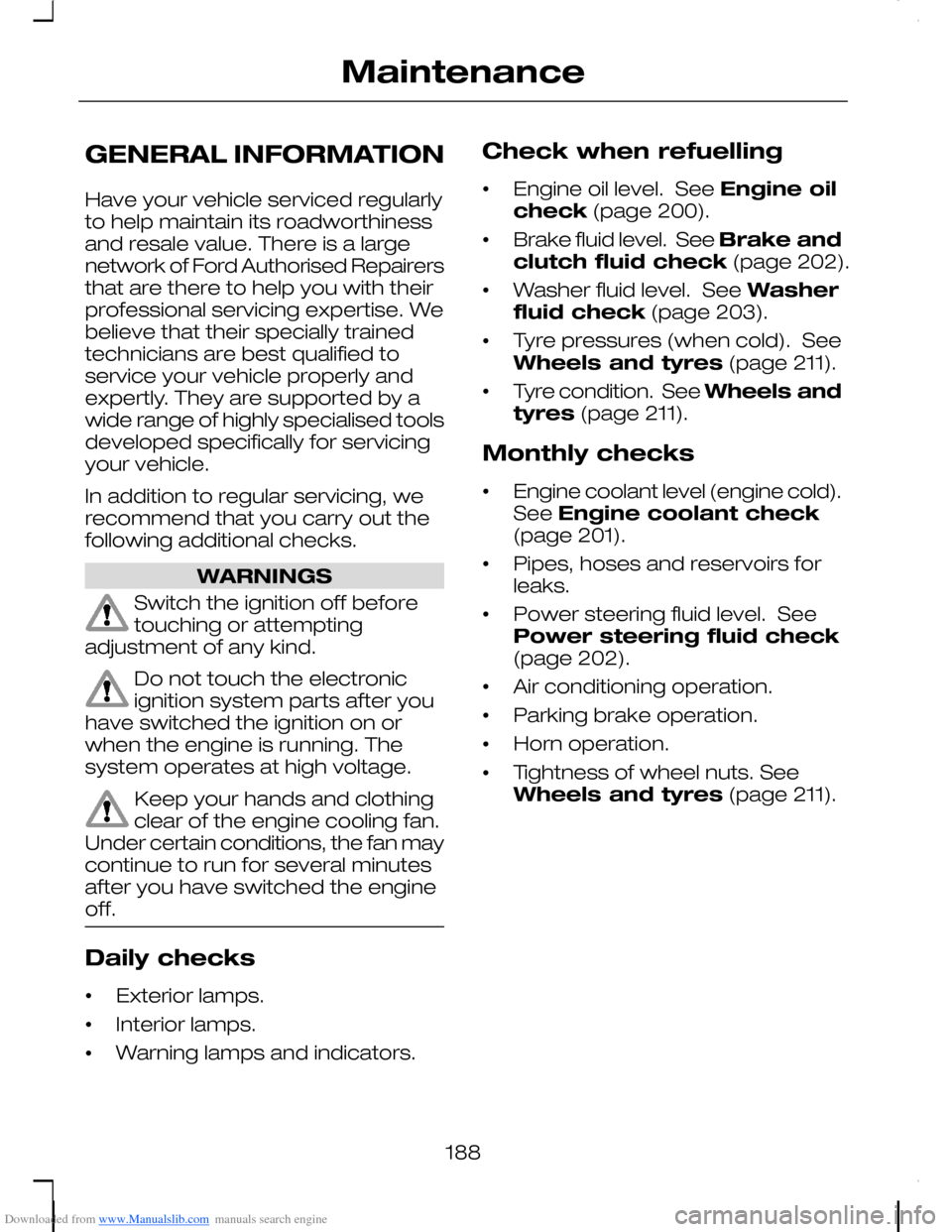
Downloaded from www.Manualslib.com manuals search engine GENERAL INFORMATION
Have your vehicle serviced regularlyto help maintain its roadworthinessand resale value. There is a largenetwork of Ford Authorised Repairersthat are there to help you with theirprofessional servicing expertise. Webelieve that their specially trainedtechnicians are best qualified toservice your vehicle properly andexpertly. They are supported by awide range of highly specialised toolsdeveloped specifically for servicingyour vehicle.
In addition to regular servicing, werecommend that you carry out thefollowing additional checks.
WARNINGS
Switch the ignition off beforetouching or attemptingadjustment of any kind.
Do not touch the electronicignition system parts after youhave switched the ignition on orwhen the engine is running. Thesystem operates at high voltage.
Keep your hands and clothingclear of the engine cooling fan.Under certain conditions, the fan maycontinue to run for several minutesafter you have switched the engineoff.
Daily checks
•Exterior lamps.
•Interior lamps.
•Warning lamps and indicators.
Check when refuelling
•Engine oil level. See Engine oilcheck (page 200).
•Brake fluid level. See Brake andclutch fluid check (page 202).
•Washer fluid level. See Washerfluid check (page 203).
•Tyre pressures (when cold). SeeWheels and tyres (page 211).
•Tyre condition. See Wheels andtyres (page 211).
Monthly checks
•Engine coolant level (engine cold).See Engine coolant check(page 201).
•Pipes, hoses and reservoirs forleaks.
•Power steering fluid level. SeePower steering fluid check(page 202).
•Air conditioning operation.
•Parking brake operation.
•Horn operation.
•Tightness of wheel nuts. SeeWheels and tyres (page 211).
188
Maintenance
Page 215 of 278
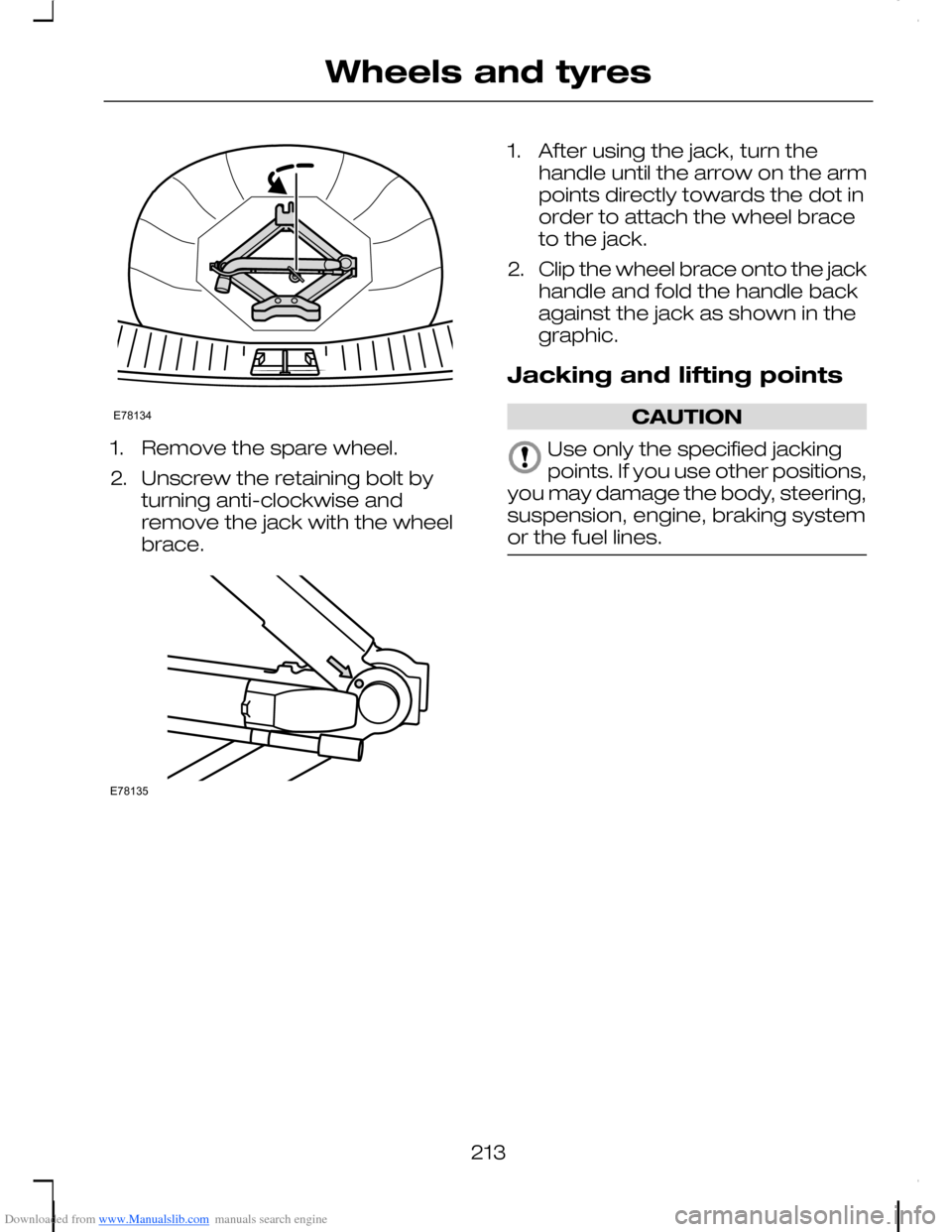
Downloaded from www.Manualslib.com manuals search engine 1.Remove the spare wheel.
2.Unscrew the retaining bolt byturning anti-clockwise andremove the jack with the wheelbrace.
1.After using the jack, turn thehandle until the arrow on the armpoints directly towards the dot inorder to attach the wheel braceto the jack.
2.Clip the wheel brace onto the jackhandle and fold the handle backagainst the jack as shown in thegraphic.
Jacking and lifting points
CAUTION
Use only the specified jackingpoints. If you use other positions,you may damage the body, steering,suspension, engine, braking systemor the fuel lines.
213
Wheels and tyresE78134 E78135
Page 219 of 278

Downloaded from www.Manualslib.com manuals search engine All vehicles
1.Fully tighten the wheel nuts in thepattern shown.
2.Press the hub cap firmly with theball of the hand.
3.Stow the locking nut and thewheel brace safely.
4.Stow the jack and defective wheelin reverse order and secure them.
Note:Have the tightening torque ofthe wheel nuts and the tyre pressurechecked as soon as possible.
TYRE REPAIR KIT
Your vehicle may not have a sparetyre. In this case it will have anemergency tyre repair kit that can beused to repair one flat tyre.
The tyre repair kit is located in thespare wheel well.
General information
WARNINGS
Depending on the type andextent of tyre damage, sometyres can only be partially sealed ornot sealed at all. Loss of tyrepressure can affect vehicle handling,leading to loss of vehicle control.
Do not use the tyre repair kit ifthe tyre has already beendamaged as a result of being drivenunder inflated.
Do not try to seal damage otherthan that located within thevisible tread of the tyre.
Do not try to seal damage to thetyre’s sidewall.
The tyre repair kit seals most tyrepunctures [with a diameter of up tosix millimetres (1/4 inch)] totemporarily restore mobility.
Observe the following rules whenusing the kit:
•Drive with caution and avoidmaking sudden steering ordriving manoeuvres,especially if the vehicle is heavilyloaded or you are towing a trailer.
•The kit will provide you with anemergency temporary repair,enabling you to continue yourjourney to the next vehicle or tyredealer, or to drive a maximumdistance of 200 kilometres(125 miles).
•Do not exceed a maximumspeed of 80 km/h (50 mph).
217
Wheels and tyresE72573